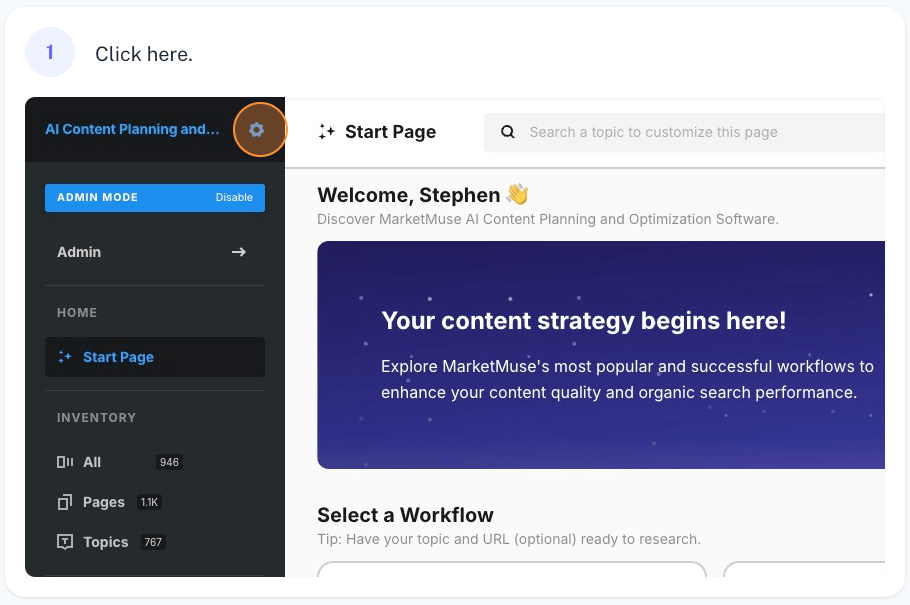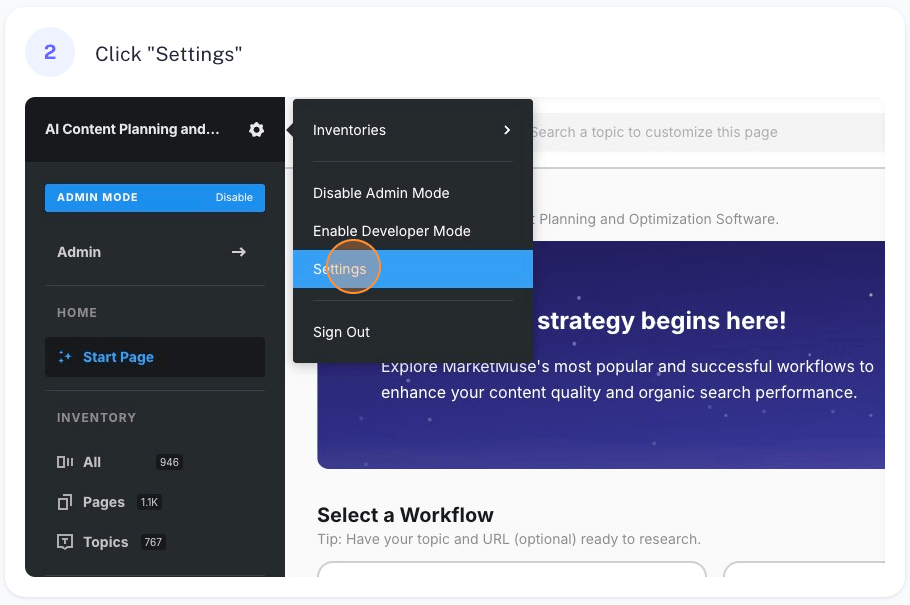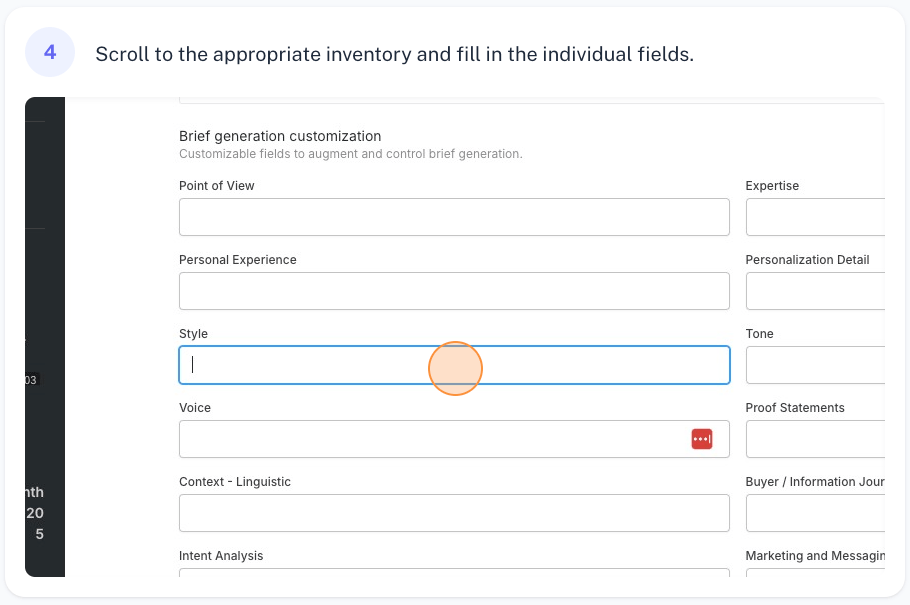Specific inputs allow you to customize a content brief when you’re producing it. You can create defaults in Settings so that these inputs are automatically filled in every time you create a brief (but you can override them at the time of brief creation).
Each site inventory has its own set of defaults.
Here’s how to set up the defaults:




Point of View (POV)
It’s the core message you want to get across. Having one keeps your message clear and focused. Plus, it guides the content brief structure and keeps it on track.
Example: “Organic food is healthier and better for the environment.”
Having this POV in a brief about organic food ensures that the outline doesn’t run counter to this position.
Expertise
Refers to the author’s depth of knowledge and proficiency in the subject matter. This component of a content brief highlights the author’s qualifications, experience, and authority in the field, guiding how they communicate their insights and understanding. The expertise element influences the selection of topics, the complexity of information, and the credibility of the content.
Example: Maria Rodale is the granddaughter of J.I. Rodale, founder of the Rodale Institute and Rodale Press, and a pioneer in organic farming and gardening. Author of five books, she’s continuing her family’s legacy by advocating for organic agriculture and sustainable living.
This element ensures the content not only matches the audience’s expectations for authoritative information but also demonstrates the author’s command of the subject, adding substantial value to the content.
Personal Experience
Content can be enriched by incorporating personal stories or anecdotes. Use this element to define how and to what extent personal experiences should be integrated. Including details of those personal experiences can enhance relatability and trustworthiness.
Personalization Detail
Involves tailoring content to meet the specific needs, interests, or characteristics of the target audience. This can include customizing examples, references, language, and tone to align with audience demographics or preferences.
Style
This refers to the overall aesthetic and structural approach of the content. It encompasses the choice of words, sentence structure, and organization of ideas, which collectively define the uniqueness of the content. Examples:
- Conversational Style: Mimics everyday speech, uses first-person narration, casual tone. Ideal for blogs, podcasts, social media posts.
- Formal Academic Style: Structured, formal language, avoids contractions, focuses on clarity. Common in scholarly articles, research papers, technical reports.
- Persuasive Style: Aims to persuade through compelling arguments and emotional appeals. Used in sales copy, advertising, opinion editorials.
- Descriptive Style: Rich in adjectives and imagery, paints a vivid picture for the reader. Used in narrative writing, travel blogs, product descriptions.
- Expository Style: Informative, fact-based, explains or informs. Common in how-to guides, manuals, business writing.
- Storytelling Style: Focuses on narrative flow with characters, conflicts, and resolutions. Used in brand storytelling, novels, marketing content.
Tone
Tone is the attitude or emotional undertone of the content, significantly impacting how the audience perceives the message. Examples:
- Casual
- Humorous
- Serious
- Enthusiastic
- Objective
Voice
Coice is the distinct personality or character of the content. It’s a consistent expression of the brand or author’s values and personality, making the content recognizable and unique. Examples:
- Authoritative
- Quirky
- Inspirational
- Friendly
- Professional
- Empathetic
- Innovative
Proof Statements
These are factual or evidential statements used to substantiate claims in the content. They include data, statistics, research findings, or expert opinions that enhance the credibility and persuasiveness of the content. The explicit examples (claim and proof statement) must be included for this to be an influential component.
Example Claim: Social media usage has a negative impact on adolescent mental health.
Example Proof Statement: A study conducted by the American Academy of Pediatrics found a correlation between increased screen time and higher rates of depression and anxiety among teenagers.
Context – Linguistic
This involves the situational factors affecting language use, such as cultural nuances, idiomatic expressions, and regional language variations. It ensures the content is appropriately and effectively communicated to the target audience.
Example: Content targeting ESL (English as a second language), or using slang from a particular region.
Buyer/Information Journey
This outlines the path a potential customer or audience member takes from realizing a need to making a decision. Understanding this journey helps tailor content to effectively guide and influence the audience at each step. Some brands have a journey documented that should be referenced by briefs. Here’s where this component is critical to add references to the specific goals of the user.
Example for a fitness app:
- Awareness — User realizes they need to improve their physical health or fitness level. Potential triggers include health scare, weight gain, lack of energy, desire to look better. Content focus should be educational articles, social media posts highlighting fitness benefits, free workout challenges.
- Consideration — User researches fitness options (gym memberships, personal trainers, fitness apps). Content focuses on app features, testimonials, comparisons with competitors, and free trial offers.
- Decision — User chooses a fitness app and signs up. Content focuses on clear pricing, easy sign-up process, strong call-to-action, and customer support information.
- Retention — User continues using the app and achieves fitness goals. Content focus is on personalized workout plans, progress tracking, community features, challenges and rewards.
Intent Analysis
This involves examining the underlying intentions or goals of the audience when they seek out content. It aids in creating content that addresses specific user needs, questions, or problems. Use this to explicitly detail exactly what intent you want.
Example: Instructional intent, learn content planning, improve content strategy, optimize content performance.
Marketing and Messaging References:
List of references that can be included which may have been generated as part of plans or are standard in a brand’s style guide. Examples:
- Brand Style Guide: A comprehensive document outlining the brand’s visual identity, tone of voice, messaging, and logo usage.
- Brand Book: Similar to a style guide but often includes more in-depth information about the brand’s history, mission, and target audience.
- Previous Marketing Campaigns: Successful campaigns can serve as inspiration or provide valuable insights into what resonates with the target audience.
- Market Research: Data and insights about the target audience, competitors, and industry trends can inform messaging and positioning.
- Customer Feedback: Insights from customers can help tailor messaging to address their needs and concerns.
- Competitor Analysis: Understanding competitors’ messaging can help identify opportunities for differentiation.
- Messaging Framework: A structured approach to developing key messages aligned with the brand’s overall objectives.
Structuring
This pertains to the organization and layout of content. It includes the use of headings, subheadings, paragraphs, lists, and other structural elements to enhance readability and comprehension.
Example: Restrict use of headings to H2 and H3 only.
Fact Statements
These are clear, verifiable statements presenting objective information. They establish trust and authority, particularly in informational or educational content. Explicit statements must be included for this to be influential to the brief.
Example: The Earth is approximately 4.54 billion years old.
Target Market
Add guidance to explicitly include industry targets, persona, location, context and knowledge/reading level if important.
- Product: A new line of organic skincare products
- Industry: Beauty and wellness
- Persona: Eco-conscious, health-oriented women aged 25-35 with a college education and a moderate income.
- Location: Urban areas in North America
- Context: Interested in natural and sustainable products, concerned about skin health and environmental impact.
- Knowledge/Reading Level: Generally knowledgeable about skincare ingredients and trends. Flesch Kincaid grade 8.
Additional Customization
Custom brief guidelines and customizable fields influence MarketMuse’s content brief generator, before creating the brief. Once a brief is ready, you can customize it further, either within the platform or by exporting it to MS Word or Google Docs (c
